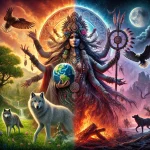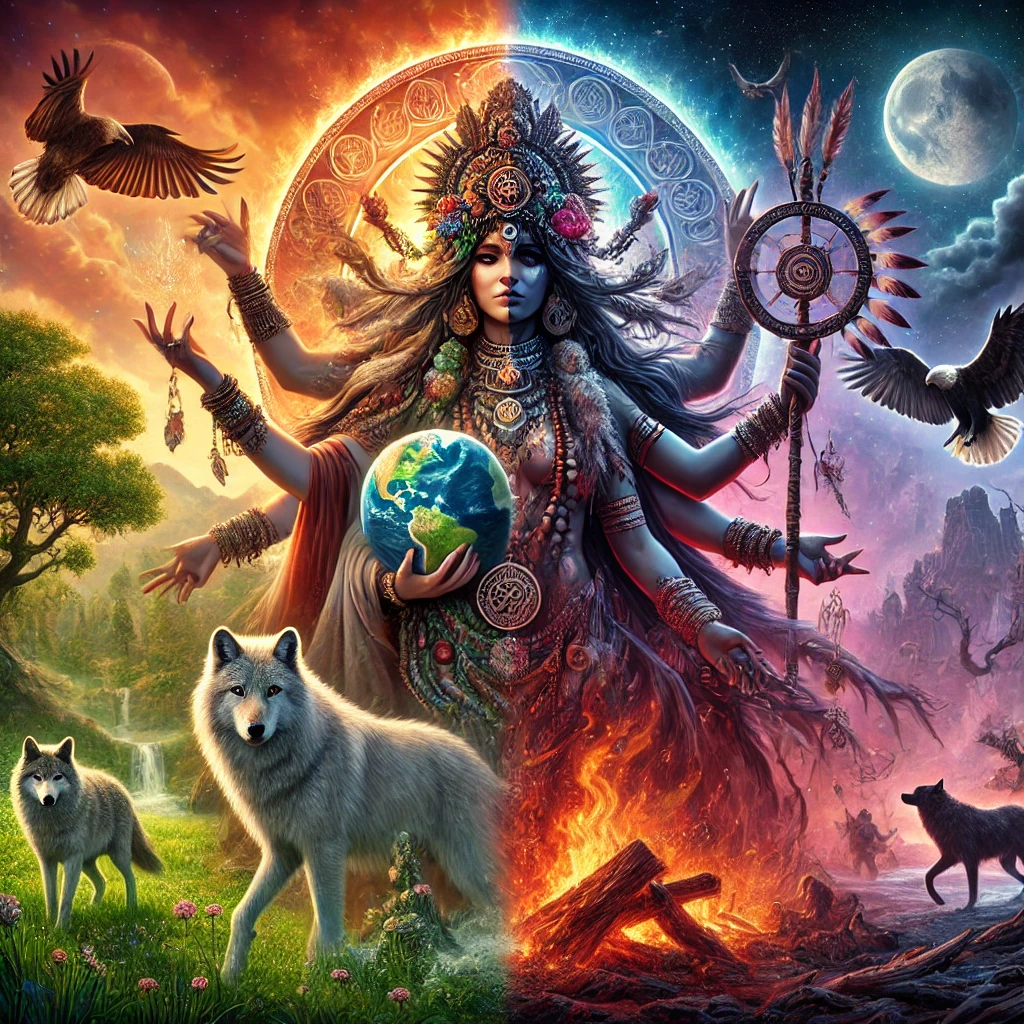Who is the Great Mother?
Who is the Great Mother? Exploring the Archetype and Its Deep Roots in Matriarchal Systems
In a time where patriarchal structures dominate much of society, spiritual teacher Amir Khalighi invites us to reconnect with an ancient and timeless force: the Great Mother. For Khalighi, the “Great Mother” is more than just a concept; it is a divine presence that infuses all creation and the cycles of life, death, and rebirth. It is the energy that runs the Ouroboros. But to truly understand who the Great Mother represents, we must look beyond the individual spiritual experience and into the deep historical roots of matriarchal systems that predate the rise of patriarchal dominance, which separated spirit from matter.
 The Great Mother: A Universal Archetype
The Great Mother: A Universal Archetype
Throughout history, the Great Mother has appeared in countless spiritual traditions and mythologies worldwide. In its essence, the Great Mother symbolizes the life-giving, nurturing power of the Universe. She is light and love manifest, the earth, the source of fertility, the cycle of creation and destruction, and the ever-present force of compassion, care, destruction, and rebirth. She is the turning wheel of life. In her embrace, all living beings find the essence of life, which accepts the transformational nature of her cycles, from the microsome to the macrocosm.
Amir Khalighi’s teachings on this topic go beyond a mere archetype. It recognizes the Divine feminine energy that exists within and outside us. This energy is not limited to biological gender but speaks to qualities often associated with femininity: intuition, empathy, compassion, and interconnectedness.
When Khalighi speaks about the Great Mother, he calls on men to reconnect with this sacred feminine energy in themselves as well as develop the Masculine structures to hold that energy. In doing so they strengthen their capacity to hold that space for their feminine counterparts. By doing so, they also have a deeper access to what is happening within, allowing the healing of wounds to begin to heal, caused mainly by toxic masculinity and the patriarchal systems that have repressed these qualities for centuries. The invitation is to cultivate balance—a union of the conscious masculine and feminine within that leads to wholeness and harmony. (See Masculine Archetypal Energies for a deeper understanding of why men move into shadow states and create pain through unconscious behaviors, also see the Three Stage Evolution of the Male Psyche)
The Matriarchal Systems That Predate Patriarchy
To truly understand the significance of the Great Mother archetype, we must look back to a time when matriarchal systems shaped human societies. Long before the rise of patriarchal dominance, many ancient cultures revered the feminine as central to their spiritual and social systems. These cultures recognized the natural cycles of life and saw the feminine as the source of creation, fertility, and community cohesion.
1. The Prehistoric Worship of the Great Mother
In prehistoric times, many archaeological findings suggest that early human societies were matriarchal or at least deeply matrifocal. Evidence of this can be seen in the Venus figurines—small sculptures of pregnant women or women with exaggerated feminine features—found in Europe, dating back as far as 30,000 years. These figures are believed to have been representations of fertility goddesses, a testament to the reverence early humans held for the feminine as the source of life.
These early societies likely viewed life through a lens that honored the earth and its natural cycles, linking them to the Great Mother. She was seen as both a life-giver and a force of renewal, overseeing the natural rhythms of birth, death, and rebirth. The connection between women and the earth—both capable of giving and sustaining life—formed the core of these early matriarchal beliefs.
2. Ancient Matriarchal Societies
Some scholars argue that many ancient societies were matriarchal or matrifocal, where power, lineage, and wealth were passed down through the female line. While the exact nature of these societies can be debated, certain civilizations offer compelling evidence of feminine-centered spiritual and social structures.
One such example is the Minoan civilization on the island of Crete, which flourished between 3000 and 1450 BCE. The Minoans are often cited as a peaceful, matrifocal society where women held important religious and social roles. The Great Mother archetype was central to their spiritual life, embodied in their worship of goddesses connected to fertility, the earth, and the cycles of nature. The art and religious artifacts left behind by the Minoans reflect a culture deeply rooted in the feminine principle, with images of women in positions of power, priestesses, and representations of nature goddesses.
In other parts of the world, such as ancient Sumer and Egypt, goddesses like Inanna and Isis held central roles in the pantheon, embodying the power of creation, fertility, and nurturing. These goddesses were reflections of the Great Mother, representing both the life-giving force of nature and the cycles of transformation. In these cultures, the feminine was not only revered but considered essential to maintaining balance within the world.
3. The Shift to Patriarchy
The shift from matriarchal or matrifocal societies to patriarchal systems occurred over time, often through the rise of warfare, hierarchical structures, and a growing emphasis on male dominance in political and religious life. The spread of Indo-European cultures, with their warrior gods and male-dominated social structures, contributed significantly to this shift. As patriarchal systems took hold, the once-venerated Great Mother was often replaced or subordinated by male gods.
This transition is evident in the mythology of many cultures. For example, in Greek mythology, the earth goddess Gaia, who once reigned supreme as the embodiment of the earth, is eventually overshadowed by the rise of the Olympian gods, led by Zeus. This reflects the broader cultural shift from feminine-centered spiritual systems to patriarchal ones, where the masculine becomes the dominant force.
However, the Great Mother archetype never fully disappeared. She persisted in various forms, often hidden beneath layers of patriarchal narratives. In Christianity, for example, the figure of the Virgin Mary echoes aspects of the Great Mother, though her role is more subdued. In many indigenous cultures, the reverence for the earth as a living, nurturing being continues to this day, demonstrating the resilience of this ancient archetype.
The Return to the Great Mother
In modern times, spiritual teachers like Amir Khalighi are calling for a return to the Great Mother—not as a rejection of the masculine, but as a way to restore balance and heal the wounds caused by centuries of patriarchal dominance. By reconnecting with the Great Mother, we are invited to honor the feminine principles of care, compassion, and interconnectedness that are so often undervalued in today’s world.
This return is not about replacing patriarchy with matriarchy but rather about integrating the divine masculine and feminine within ourselves and our societies. It’s about recognizing the importance of nurturing and creation alongside action and power. In doing so, we can foster a more harmonious, compassionate world.
Conclusion: Who is the Great Mother?
Who is the Great Mother? She is the embodiment of life itself, the force that nurtures, sustains, and transforms. She is the earth, the cycles of nature, and the deep well of compassion that resides in every human being. By reconnecting with the Great Mother, we not only heal our own relationships with the feminine but also contribute to the healing of our world.
In honoring the Great Mother, we remember the ancient wisdom of matriarchal systems that recognized the importance of balance, interconnectedness, and care for all living beings. And as we integrate these lessons into our lives today, we move closer to a future where the masculine and feminine exist in harmony, guiding us toward a more compassionate, whole, and conscious way of living.
By asking ourselves who is the Great Mother, we open the door to a deeper understanding of the spiritual and historical importance of the divine feminine and its ongoing relevance in our modern lives.


 The Great Mother: A Universal Archetype
The Great Mother: A Universal Archetype